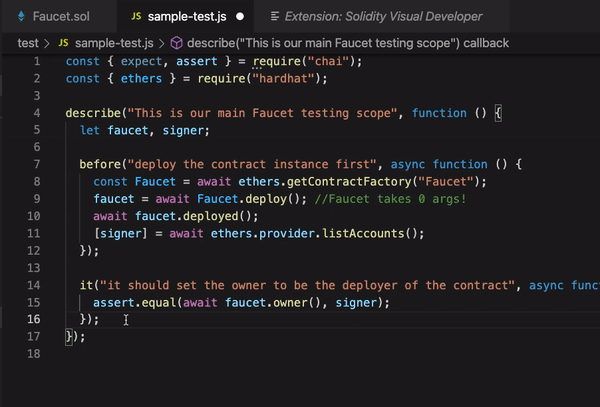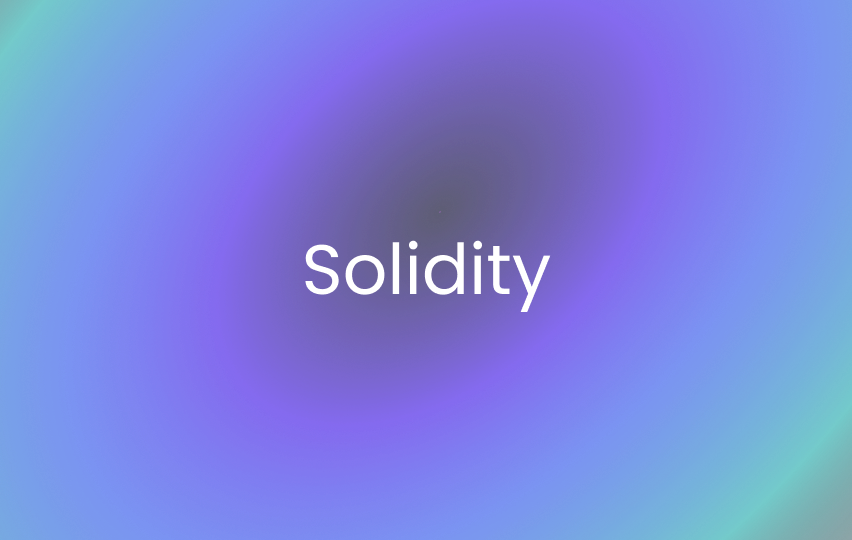Table of Contents
Solidity definition
Solidity is a programming language for writing smart contracts on the Ethereum blockchain. It is a high-level language that is similar to JavaScript and C++, and is designed to be easy to learn and use.
Smart contracts are self-executing contracts with the terms of the agreement between buyer and seller being directly written into lines of code. The code and the agreements contained therein exist across a distributed, decentralized blockchain network. Solidity is used to write these smart contracts, which are compiled into bytecode and deployed to the Ethereum blockchain.
Key features of Solidity
It was developed by the Ethereum Foundation, and is the most popular language for developing smart contracts on the Ethereum blockchain. Here are some of its features that make it so loved among developers.
1) Strong typing
It is a strongly-typed language, which means that all variables and expressions have a specific type, such as string, int, or address. This helps to prevent errors and improve code quality.
2) Inheritance
It supports inheritance, which allows classes to inherit attributes and methods from parent classes. This allows for the creation of complex class hierarchies, and makes it easy to reuse and extend existing code.
3) Libraries
It includes a number of built-in libraries for common tasks, such as arithmetic, cryptography, and string manipulation. This makes it easy to perform common tasks without having to write code from scratch.
4) Security
It includes a number of features to help ensure the security of smart contracts, such as access control, gas limits, and automatic garbage collection. This helps to prevent common vulnerabilities, such as reentrancy attacks and integer overflows.
5) Tooling
It is supported by a number of tools, including compilers, debuggers, and IDEs, which make it easy to write, compile, and debug smart contracts.
Overall, Solidity is a powerful and popular language making it a valuable skill for anyone wanting to become a blockchain developer.
How to write a basic smart contract in Solidity
1. Open a text editor or use an online Solidity compiler
A recommended tool would be one such as Remix IDE.
2. Specify the Solidity version you want to use with a pragma directive
The pragma directive is a line of code at the top of the contract that specifies the version that the contract is written in, as well as any other compiler options that should be used.
For example:
pragma solidity ^0.6.12;The caret symbol (^) before the version number specifies that the compiler should use the latest version of Solidity that is compatible with the specified version.
3. Define the contract
Specify the contract name and any inheritance relationships it has with other contracts. Inheritance allows a contract to reuse the code and functionality of another contract, which can make it easier to build complex contracts. To define a contract, use the contract keyword followed by the contract name and a set of curly braces.
For example:
contract MyContract {
// contract body goes here
}4. Declare any state variables
State variables are variables that are stored on the Ethereum blockchain and are part of the contract’s permanent state. To declare a state variable, use a visibility specifier (such as public or private) followed by the variable type and the variable name.
For example:
uint public count;This declares a uint (unsigned integer) state variable called count that is publicly visible.
5. Define a constructor function
This function can be used to initialize the contract’s state. To define a constructor function, use the constructor keyword followed by a set of parentheses and a set of curly braces.
For example:
constructor() public {
count = 0;
}6. Define any functions
Functions are methods that can be called on the contract to perform various tasks or modify the contract’s state. To define a function, use the function keyword followed by the function name, a set of parentheses, and a set of curly braces.
For example:
function increment() public {
count++;
}This defines a function called increment that increments the value of the count state variable by 1.
7. Define any events
This is optional. Events are used to emit logs that can be accessed from external applications or contracts. To define an event, use the event keyword followed by the event name and a set of parentheses containing the event parameters.
For example:
event Incremented(uint newCount);This defines an event called Incremented that takes a single parameter called newCount of type uint.
8. Define any modifiers
This also is optional. Modifiers are used to change the behavior of functions by adding additional checks or conditions. Define any modifiers that your contract will use by specifying their name and any parameters they take. You can then use the modifier keyword to apply the modifier to a function.
For example:
modifier onlyOwner {
require(msg.sender == owner, "Only the owner can perform this action.");
_;
}9. Define any libraries or interfaces that the contract will use
Define the library or interface using the library or interface keyword, followed by the name of the library or interface.
For example:
library MyLibrary {
// library functions go here
}
interface MyInterface {
// interface functions go here
}10. Test and debug the contract using a Solidity compiler or debugger
Here is an example of a complete Solidity contract that uses all of the components shown separately above 👇🏼
pragma solidity ^0.6.12;
contract MyContract {
uint public count;
address public owner;
constructor() public {
count = 0;
owner = msg.sender;
}
function increment() public {
count++;
}
function decrement() public {
count--;
}
function getCount() public view returns (uint) {
return count;
}
event Incremented(uint newCount);
event Decremented(uint newCount);
modifier onlyOwner {
require(msg.sender == owner, "Only the owner can perform this action.");
_;
}
}Pretty easy, right?
Fun facts about Solidity
- Solidity was developed by the Ethereum Foundation and first released in 2015.
- It’s named after the concept of “solidity” in philosophy, which refers to the idea of something being “firmly established, real, or stable”.
- It is inspired by other programming languages, such as JavaScript and C++.
- It is the most popular language for writing smart contracts on the Ethereum blockchain and several web3 learning platforms like Metaschool, LearnWeb3DAO and more teach Solidity.
- Solidity is a strongly-typed language, which means that all variables and expressions have a specific type.
- The programming language supports inheritance, which allows classes to inherit attributes and methods from parent classes.
- Solidity includes a number of built-in libraries for common tasks, such as arithmetic and cryptography.
- The programming language includes features to help ensure the security of smart contracts, such as access control and gas limits.
- Solidity’s supported by a number of tools, including compilers, debuggers, and IDEs.
- It is used by a number of high-profile projects, such as MakerDAO and Augur.
How to learn Solidity as a beginner
Solidity allows developers to create complex, decentralized applications that can be executed on the Ethereum network. These applications, called dApps, can be used for a wide range of purposes, including financial transactions, supply chain management, and voting systems.
Solidity is a powerful tool for building dApps, and is an important part of the Ethereum ecosystem.

Solidity developers are in high demand due to the increasing popularity of blockchain technology and the use of Solidity as a blockchain programming language for developing contracts on the Ethereum platform.
Companies and organizations are seeking experienced Solidity developers to help build and maintain decentralized applications (dApps) and other blockchain-based projects. In return for your skills, they’re paying big bucks. Let’s see what you need to know to be chosen by one of these companies.
1. Install the necessary tools
Solidity is a language for the Ethereum blockchain, so you will need to install the Ethereum development tools, such as the MetaMask Wallet and the Solidity compiler. These tools are available for a variety of operating systems, including Windows, Mac, and Linux.
2. Learn the basics of Solidity
Solidity is a high-level language that is similar to JavaScript and C++, so if you have experience with those languages, you will have a good starting point. In fact it’s advisable to have prior programming experience. However, even if you don’t have any, you can still learn the basics of Solidity by reading the official Solidity documentation and tutorials and build up from there.
3. Practice writing Solidity code
The best way to learn a programming language is to practice writing code. You can try writing simple Solidity programs and smart contracts, and then run them using the Solidity compiler to see how they work. This will help you understand the syntax and semantics of the language, and get a feel for how to write Solidity code.
4. Explore the Ethereum ecosystem
Solidity is an Ethereum language, so it’s important to understand the ecosystem in which it operates. This includes learning about the Ethereum blockchain, the Ethereum Virtual Machine (EVM), and its community. You can read up on these topics, and explore the blockchain and its applications to get a better understanding of how Solidity fits into the broader ecosystem.
5. Join the Solidity community
Solidity is an open-source language, and there is a vibrant community of developers, users, and enthusiasts who are working with Solidity and the Ethereum blockchain. You can join forums, chat rooms, and even other online communities to learn Solidity, share your own experiences, and get help when you need it.
Overall, getting started in Solidity programming as a beginner can be a challenging but rewarding journey. By following these steps and learning from others, you can gain the knowledge and skills you need to become a proficient Solidity programmer and contribute to the Ethereum ecosystem.
